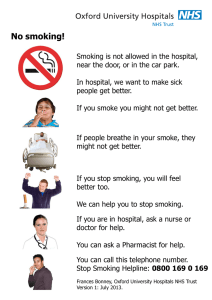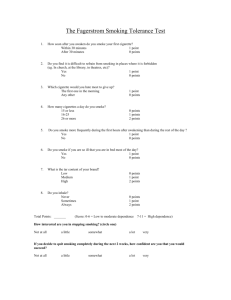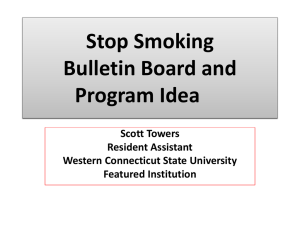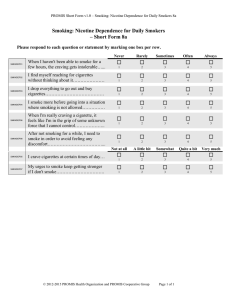Downloaded - Geography - University of Canterbury
advertisement
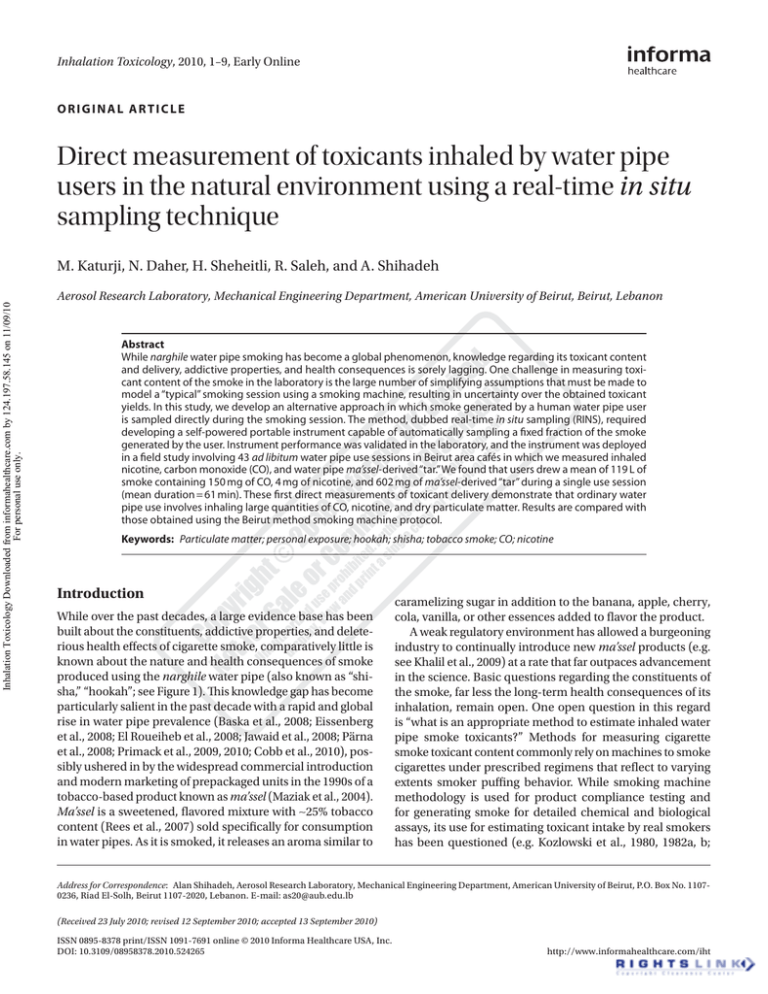
Inhalation Toxicology, 2010, 1–9, Early Online ORIGINAL ARTICLE Direct measurement of toxicants inhaled by water pipe users in the natural environment using a real-time in situ sampling technique Inhalation Toxicology Downloaded from informahealthcare.com by 124.197.58.145 on 11/09/10 For personal use only. M. Katurji, N. Daher, H. Sheheitli, R. Saleh, and A. Shihadeh Aerosol Research Laboratory, Mechanical Engineering Department, American University of Beirut, Beirut, Lebanon Abstract While narghile water pipe smoking has become a global phenomenon, knowledge regarding its toxicant content and delivery, addictive properties, and health consequences is sorely lagging. One challenge in measuring toxicant content of the smoke in the laboratory is the large number of simplifying assumptions that must be made to model a “typical” smoking session using a smoking machine, resulting in uncertainty over the obtained toxicant yields. In this study, we develop an alternative approach in which smoke generated by a human water pipe user is sampled directly during the smoking session. The method, dubbed real-time in situ sampling (RINS), required developing a self-powered portable instrument capable of automatically sampling a fixed fraction of the smoke generated by the user. Instrument performance was validated in the laboratory, and the instrument was deployed in a field study involving 43 ad libitum water pipe use sessions in Beirut area cafés in which we measured inhaled nicotine, carbon monoxide (CO), and water pipe ma’ssel-derived “tar.” We found that users drew a mean of 119 L of smoke containing 150 mg of CO, 4 mg of nicotine, and 602 mg of ma’ssel-derived “tar” during a single use session (mean duration = 61 min). These first direct measurements of toxicant delivery demonstrate that ordinary water pipe use involves inhaling large quantities of CO, nicotine, and dry particulate matter. Results are compared with those obtained using the Beirut method smoking machine protocol. Keywords: Particulate matter; personal exposure; hookah; shisha; tobacco smoke; CO; nicotine Introduction While over the past decades, a large evidence base has been built about the constituents, addictive properties, and deleterious health effects of cigarette smoke, comparatively little is known about the nature and health consequences of smoke produced using the narghile water pipe (also known as “shisha,” “hookah”; see Figure 1). This knowledge gap has become particularly salient in the past decade with a rapid and global rise in water pipe prevalence (Baska et al., 2008; Eissenberg et al., 2008; El Roueiheb et al., 2008; Jawaid et al., 2008; Pärna et al., 2008; Primack et al., 2009, 2010; Cobb et al., 2010), possibly ushered in by the widespread commercial introduction and modern marketing of prepackaged units in the 1990s of a tobacco-based product known as ma’ssel (Maziak et al., 2004). Ma’ssel is a sweetened, flavored mixture with ∼25% tobacco content (Rees et al., 2007) sold specifically for consumption in water pipes. As it is smoked, it releases an aroma similar to caramelizing sugar in addition to the banana, apple, cherry, cola, vanilla, or other essences added to flavor the product. A weak regulatory environment has allowed a burgeoning industry to continually introduce new ma’ssel products (e.g. see Khalil et al., 2009) at a rate that far outpaces advancement in the science. Basic questions regarding the constituents of the smoke, far less the long-term health consequences of its inhalation, remain open. One open question in this regard is “what is an appropriate method to estimate inhaled water pipe smoke toxicants?” Methods for measuring cigarette smoke toxicant content commonly rely on machines to smoke cigarettes under prescribed regimens that reflect to varying extents smoker puffing behavior. While smoking machine methodology is used for product compliance testing and for generating smoke for detailed chemical and biological assays, its use for estimating toxicant intake by real smokers has been questioned (e.g. Kozlowski et al., 1980, 1982a, b; Address for Correspondence: Alan Shihadeh, Aerosol Research Laboratory, Mechanical Engineering Department, American University of Beirut, P.O. Box No. 11070236, Riad El-Solh, Beirut 1107-2020, Lebanon. E-mail: as20@aub.edu.lb (Received 23 July 2010; revised 12 September 2010; accepted 13 September 2010) ISSN 0895-8378 print/ISSN 1091-7691 online © 2010 Informa Healthcare USA, Inc. DOI: 10.3109/08958378.2010.524265 http://www.informahealthcare.com/iht 2 M. Katurji et al. mouthpiece tobacco charcoal head hose Inhalation Toxicology Downloaded from informahealthcare.com by 124.197.58.145 on 11/09/10 For personal use only. body bowl water Figure 1. Schematic of a narghile water pipe. The head, body, water bowl, and hose are the primary elements from which the water pipe is assembled. Tobacco is loaded into the head, and burning charcoal is placed on top of the tobacco. When a user inhales from the mouthpiece, air and hot charcoal fumes are forced through the tobacco, raising its temperature, and generating the desired smoke. The smoke exits from the bottom of the head, into the body, and through the bubbler and hose to the user. The water pipe illustrated here, and used in this study, is configured for use with sweetened and flavored tobacco, known as ma’ssel. When ma’ssel is used, a relatively deep (∼3 cm) head is filled with 10–20 g of the flavored tobacco mixture and covered with an aluminum foil sheet that is perforated for air passage. Burning charcoal is placed on top of the aluminum foil to provide the heat needed to generate the smoke (reprinted from Daher et al., 2010). Hammond et al., 2006; Burns et al., 2008; Marian et al., 2009). Among other reasons, idiosyncrasies in user behavior make representing the smoking session with a machine difficult (e.g. repeated lighting of a pipe or cigar, varying ventilation blocking by lips or fingers, adjusting charcoal on a water pipe head). In addition, reproducing the smoking device itself is challenging when nonstandard tobacco products are used (e.g. roll-your-own cigarettes, pipes). With the water pipe, variability is endemic; the amount of tobacco and charcoal loaded, the density of the packed tobacco, the number of users sharing it, the degree to which fresh air infiltrates into the hose (Saleh and Shihadeh, 2008), and other variables can affect toxicant yields and are difficult to characterize and standardize for the laboratory. One accepted alternative to smoking machine methods has been chemical analysis of spent cigarette butts (e.g. Kozlowski et al., 1982a, b; Green et al., 1985; Watson et al., 2004; O’Connor et al., 2007; see Pauly et al., 2009). This indirect method is based on correlation between quantities of toxicants trapped in the spent cigarette butt and quantities delivered during smoking, and the method has many practical advantages for standardized cigarettes, ecological validity foremost among them. Some disadvantages include inability to measure gas-phase toxicants such as CO and volatile aldehydes and imprecision in estimates of toxicant trapping efficiency of the cigarette butt. Another alternative is to directly sample humangenerated smoke in real time. In this study, we explore the use of a sampling technique in which a small proportion of each puff generated by a human is directly captured for chemical analysis. During each puff, a smoke sample is drawn through a glass fiber filter and exhausted into a sealed inert bag for off-line chemical analysis of the particle- and gas phases. While development of such a real-time in situ sampling (RINS) approach was motivated by difficulty accounting for water pipe smoker idiosyncrasies in the analytical laboratory, RINS is in principle applicable to any smoking device. Its principle advantage is that it makes possible the assessment of toxicant intake by real smokers in their natural settings, with no need for idealizations of the smoker or the device. It also allows for simultaneous measurement of smoking topography. This study reports the design and performance characterization of a RINS instrument as well as measurements of smoking topography, CO, nicotine, and ma’ssel-derived “tar” delivery of a sample of 43 narghile water pipe use sessions in Beirut area cafés. A comparison is made with previously measured toxicant yields obtained with a smoking machine. Materials and methods Instrument description A schematic of the RINS instrument connected to a water pipe is given in Figure 2. RINS automatically samples a fraction of the smoke flowing through the mouthpiece whenever a smoker inhales from it. The sampled smoke is drawn through a glass fiber filter by a digitally controlled miniature diaphragm pump that exhausts into an inert bag. The inhaled and sampled flow rates are monitored and recorded continuously by the RINS control software. At the end of each smoking session, the filter pad and contents of the bag are analyzed to assess toxicant exposure, and smoker topography (e.g. number of puffs, puff volume, duration, interpuff interval; see Shihadeh et al., 2004) is recorded. An important feature of this system is its portability. Except for a laptop computer and the modified water pipe hose, the entire setup, including a battery power supply, is contained in a small laptop computer case and is convenient to setup wherever water pipes are normally used. Key variables in the operation are the mainstream smoke flow rate drawn by the smoker in the mouthpiece, Q, and the minor flow drawn by the instrument just upstream of the mouthpiece, q. The fraction sampled, f, is defined as the ratio q/Q. Water pipe users generate and inhale a smoke stream characterized by a time-varying flow rate and chemical composition. To ensure that a correctly weighted sample Inhaled waterpipe smoke toxicants 3 mouthpiece/ probe assembly glass fiber filter flexible tube Carrying case ∆P obstruction flow meter pressure transducer ∆P look up control signal ∆V pusation damper flow rate Inhalation Toxicology Downloaded from informahealthcare.com by 124.197.58.145 on 11/09/10 For personal use only. Tedlar bag time save smoker and sample flow rates USB daq control voltage op-amp miniature vacuum pump pulsation damper hot wire mass flow sensor battery power supply to laptop computer Figure 2. Schematic of the real-time in situ sampling (RINS) instrument connected to a water pipe. (See colour version of this figure online at www. informahealthcare.com/iht) is collected from this unsteady flow, the sampling flow rate must continuously vary in direct proportion to the mainstream flow rate. For the purposes of the present study, a nominal desired sample yield of 25 mg of total particulate matter (TPM) requires a sampled fraction of ∼2%, given an average expected mainstream smoke TPM yield of 1400 mg per water pipe use session (Shihadeh and Saleh, 2005). With a characteristic flow dimension of 1 cm in the water pipe hose and f = 1.95%, the probe diameter for required for isokinetic sampling (see Brockman, 2001) is calculated as 1.4 mm. Conservatively assuming a flow rate and particle size of 20 lpm and 1 μm, respectively, this probe diameter yields an inlet Stokes number of ∼0.01 indicating that particle inertia will not affect probe aspiration efficiencies (Brockman, 2001). Therefore, the instantaneous free stream and sampling probe velocities can differ significantly without particle size sampling biases, meaning that f need not be restricted to the value corresponding to isokinetic sampling for this probe size. It is important, however, that f remains constant and known. To achieve this, the RINS controller continuously monitors the flow rate in the hose using an obstruction meter previously developed to measure smoking topography (Shihadeh et al., 2005). Based on the input f, the controller generates a pump control voltage that yields the desired instantaneous sampling flow rate, q(t) = f·Q(t). The actual resulting flow rate generated by the sampling pump is measured by a 3 msec response hot wire mass flow sensor located upstream of the pump. The signals of the hotwire flow sensor and the hose obstruction meter are stored as the smoking session proceeds, allowing for postprocessing of smoking topography data as well as numerical integration of the sampling flow rate signal to determine the total sampled volume. This algorithm, coded in Labview©, is run at 10 Hz, and is interfaced via a USB data acquisition and control card (NI USB-6008) whose analog output signal is current-amplified by an external opamp and sent to the miniature sampling pump, as shown in Figure 2. A key element of the instrument is its mouthpiece/sampler assembly. As shown in Figure 2, the sampling probe 4 M. Katurji et al. Inhalation Toxicology Downloaded from informahealthcare.com by 124.197.58.145 on 11/09/10 For personal use only. and filter are mounted in a wye configuration with the mouthpiece. The probe is made of seamless thin-walled stainless steel hypodermic tubing, while the holder is machined from polycarbonate plastic. The probe is concentric with the hose, and the inlet is located far enough upstream that the flow is unaffected by the bend leading to the mouthpiece, according to a 3-D flow computer simulation implemented in Fluent©. The mouthpiece is made of wood and was part of an original water pipe hose. The added weight of the assembly is ∼100 g. Incorporation of the filter holder into the mouthpiece minimizes sample transport losses. Particle diffusion and settling in the probe section were calculated (Brockman, 2001) over a range of particle sizes and were found to be negligible for the relevant flow conditions. Laboratory validation The performance of the RINS was characterized by connecting it to a water pipe that was smoked using a smoking machine (Shihadeh and Azar, 2006). Ma’ssel-derived “tar,” TPM, and displaced volume measured using RINS and the smoking machine were compared over a range of programmed smoking conditions. Displaced volumes were also compared on an individual puff-by-puff basis to check that a proportional volume of each individual puff had indeed been sampled. Twenty-one smoking sessions were executed, with average flow rates varying from 9 to 15 lpm, puff durations from 2 to 5 sec, total number of puffs drawn from 50 to 182, and with f set to the isokinetic sampling condition (1.95%). For each of the smoking sessions, the water pipe was prepared using 10 g of “Two Apples” (Nakhla brand) tobacco mixture and a single easy light charcoal briquette (Three Kings, Holland) was lit and placed on top of the water pipe head at the beginning of the smoking session. For sessions that involved >105 puffs, a second half-briquette was placed on the water pipe head at the 105th puff. Particulate matter exiting the water pipe mouthpiece was collected on 47-mm glass fiber filters (Pall, Type A/E), while that sampled by the RINS instrument was collected on 25-mm glass fiber filters (Pall, Type A/E). Ma’ssel-derived “tar” concentrations for the mainstream and sample stream were determined by pre- and postweighing the filters on a 0.1 mg balance, analyzing water content using a modified Karl-Fischer titration method, and dividing the dry masses (= total – water) by the measured volumes drawn through the mouthpiece and sampler, respectively. Other details regarding the machine-smoking protocol used in the study are given in Shihadeh and Saleh (2005). Actual volume sampled through the probe, Vsampled = ∫ q (t ) dt during machine smoking was compared with desired sample volume, calculated as Videal = f ∫ Q (t ) dt , where q(t) is the instantaneous probe flow rate reported by the RINS hot wire flow sensor and Q(t) is the flow rate reported by the smoking machine. Field study A field study was conducted to measure inhaled ma’sselderived “tar”, nicotine, CO, and smoking topography parameters for water pipes smoked by human users in their natural settings. We sampled 49 water pipe use sessions during the period September 2006 through September 2007 in two popular cafés in Beirut, Lebanon where narghile water pipes and food are served. Operator error or equipment malfunction resulted in discarding the data of six of these sessions. The primary sampling location, located on the Ras Beirut coastal road, was chosen because of its convenient proximity to the American University of Beirut and because the relaxed, informal outdoor setting of the café lent itself to our ability to conduct the study without disrupting business. In addition, the café caters to a range of ages and socioeconomic statuses, and is a popular destination for narghile café smoking with a view of the sea. To obtain a random sample of water pipe use sessions, we asked the food servers to inform us whenever a ma’ssel water pipe was ordered. Once notified, we approached the café patron and described the nature of the study and the equipment involved, and asked for permission to sample her/his smoke. Sixty-five percent of those we approached agreed. The sampling instrument was then attached to the water pipe, and we instructed the café patron to smoke “as usual” and to summon us directly or through a food server whenever s/he finished smoking. We then withdrew to a distant but within-view table in the café, where we read and ordered food to blend into the environment and to ensure that occupying a table was not an economic burden on the café. Because the patron usually had company, and because of the leisurely disposition of the study personnel as they ate and read at a distant table, we believe that the study had minimal impact on the manner in which the water pipe was smoked, apart from potential interference caused by the feel of the mouthpiece sampler itself. At the end of the smoking session, we returned to the participant’s table, analyzed the smoke vapors for CO content, and removed the particulate filter from the instrument. The filter was placed in a numbered, airtight container and wrapped in aluminum foil to prevent light from degrading the sample. At the end of the sampling day, all the filter samples were taken to the laboratory, weighed, and either analyzed for moisture (in order to determine ma’ssel-derived “tar” = TPM – moisture) using a modified Karl-Fischer technique (see Shihadeh and Saleh, 2005 for details) or stored in a freezer at −4°C until they were chemically analyzed for nicotine content. Filters analyzed for nicotine were extracted in ethyl acetate and toluene and analyzed by GC-MS as described in Shihadeh and Saleh (2005). An electrochemical sensor was used to measure the carbon monoxide concentration in the sample bag, and the inhaled CO was then calculated by multiplying the measured CO concentration by the measured volume of smoke drawn. Because the participants in the field study were anonymous and because their participation in the study could not place them at any reasonable risk, the field study protocol was deemed IRB exempt in accordance with US Code 45 CFR 46.101(b)(2). Inhaled waterpipe smoke toxicants 5 Laboratory validation Measurements comparing session-integrated mainstream and sampler-drawn volumes and particulate matter concentrations for the 21 machine-smoking sessions described above resulted in an average error in sampled volume of ∼0.1% and an average error in particulate mass concentration of 1.1%. Both sampled volume and sampled particulate mass concentration showed high correlation (r > 0.97) with the smoking machine measures. Typical traces of smoking machine and sampling probe flow rates are shown in Figure 3 for four consecutive machine-drawn puffs. The sampler reproduces the patterns generated by the machine in detail, but exhibits a small time lag. Because of the small Stokes numbers, however, the instantaneous difference in flow velocities between the mainstream and probe resulting from the lagging response are unimportant from a sampling efficiency perspective for the bulk of each puff. While minimal variation between sampler and mainstream flow velocities is desirable, the more important criterion for the current application is that each puff drawn by the smoker be proportionally sampled. In Figure 4, the volume drawn through the probe is plotted against that drawn through the mouthpiece on a puff-by-puff basis for a single machine-smoking session that “played back” a previously recorded 1-h smoking event by a 26-year-old male smoker in a café (Shihadeh and Azar, 2006). As shown in the figure, the sampled and mouthpiece puff volumes are linearly related (r > 0.99), indicating the sampler’s proportional sampling accuracy over a wide range of conditions. The measured sampling fraction was f = 0.0194, an error of <1% relative to the programmed value of 0.0195. smoking machine flow rate (arbitrary units) Inhalation Toxicology Downloaded from informahealthcare.com by 124.197.58.145 on 11/09/10 For personal use only. Results 0 5 10 REALTIME 15 20 time (sec) 25 30 35 Figure 3. Time traces for smoking machine and real-time in situ sampler (RINS) flow rate (scaled by 1/f) when the RINS instrument is attached to the machine-smoked water pipe. The machine was programmed to follow pre-recorded realistic human puffing pattern. Water pipe use session characteristics Table 1 summarizes the characteristics of the use sessions recorded in the field study. As shown, >80% of the water pipes were smoked by single users, with the remainder smoked by dyads. “Two Apples” flavored tobacco was the most common flavor used, followed by grape, mint, and rose. More than 60% of the water pipes sampled were used by self-reported water pipe-only smokers; the remainder was smoked by users reporting regular cigarette consumption in addition to water pipe use. Puff topography Table 2 summarizes the smoking topography data. The data are broadly consistent with previous data we have gathered, though it should be noted that the previous 171 puff standard smoking session derived in Shihadeh et al. (2004) was based on extrapolation from topography records of only the first 30 min of the smoking sessions sampled. The current data, in contrast, are based on the entire water pipe use session, regardless of its duration. It should also be noted that four of the smokers we sampled (all singletons) drew >400 puffs in 0.045 0.04 y = 0.0194x 0.035 Sampled volume (L) Data analysis Mean and 95% confidence intervals were computed for all measures. Confidence intervals were computed using twotailed Student’s t-distribution. Probability values below 0.05 were taken to indicate a statistically significant difference. Pearson product correlation coefficients, r, were also tested for significance using two-tailed t-distribution. 0.03 0.025 0.02 0.015 0.01 0.005 0 0 0.5 1 1.5 2 2.5 Smoking machine puff volume (L) Figure 4. Real-time in situ sampling versus smoking machine-drawn puff volume for a 1-h human-mimic smoking session. Each circle represents a single puff event of a 182-puff human-mimic smoking session. (See colour version of this figure online at www.informahealthcare.com/iht) Table 1. Water pipe session and user characteristics for the café sampling campaign of September 2006–September 2007. Water pipe session and user characteristics Number of singleton sessions 36 Number of dyad sessions 7 Tobacco flavor smoked (apple/grape/mint/rose) 22/12/5/4 Median age (interquartile range) 26 (23–33) Male/female 34/16 Median water pipe use frequency (/month) 8 Percent users who use water pipe at least 20 times/month 30% Median years of water pipe use (interquartile range) 6 (4–9) A total of 49 smoking sessions were recorded. The total number of users was greater than the number of smoking sessions because there were 7 dyads. No sessions had more than two persons sharing a narghile water pipe. 6 M. Katurji et al. Nicotine Mean nicotine intake for 17 determinations was 4.82 ± 1.07 mg. Nicotine intake increased with inhaled volume, though the correlation was slightly short of 95% significance (Figure 6; P < 0.064). Mean nicotine concentration was 0.034 ± 0.008 mg/L of smoke. Water and ma’ssel-derived “tar” Water content was determined for 11 filter samples and found to be highly correlated to TPM (P < 0.0001), as Table 2. Summary of smoking topography results (mean ± 95% confidence interval). Current study Shihadeh et al. (2004) Total smoking time 64.0 ± 8.4 61 (min) Number of puffs 220 ± 34 171 Smoke drawn (L) 130 ± 21 91 Puff duration (sec) 2.83 ± 0.27 2.6 Puff volume (mL) 626 ± 88 530 Interpuff interval (sec) 17.4 ± 3.0 17 10 y = 0.028x 8 6 4 2 0 0 50 100 150 200 250 300 Inhaled volume (L) Figure 6. Inhaled nicotine versus inhaled volume (r = 0.459, P < 0.064). Filled triangle corresponds to previously reported mean nicotine yield from smoking machine measurements (Shihadeh and Saleh, 2005). (See colour version of this figure online at www.informahealthcare.com/iht) 400 1000 y = 1.170x y = 0.464x 800 Water-(mg) 300 CO (mg) Inhalation Toxicology Downloaded from informahealthcare.com by 124.197.58.145 on 11/09/10 For personal use only. Toxicant intake Carbon monoxide The mean carbon monoxide intake for 43 determinations was 150 ± 26 mg (mean ± 95% CI). Individual session CO data are plotted as a function of inhaled volume in Figure 5. Data were highly correlated (P < 0.0001) with inhaled volume, with an average slope of 1.17 mg CO per liter of smoke. shown in Figure 7. Using the fitted slope of 46.4%, inhaled ma’ssel-derived “tar” was computed for the 41 TPM determinations and found to be 640 ± 119 mg per water pipe use session. Directly measured (Tarm = TPM − water) and computed (Tarc =0.464 × TPM) ma’ssel-derived “tar” were found to be highly correlated with inhaled volume (P < 0.0001 and P < 0.001, respectively). Computed ma’ssel-derived “tar” intake versus inhaled volume is plotted in Figure 8; an average slope of 4.8 mg ma’ssel-derived “tar” per liter of smoke is found. It should be noted that due to the differing combustion conditions and materials involved (e.g. water pipe ma’ssel typically contains 25% tobacco whereas the cigarette rod is largely tobacco-derived), ma’ssel-derived “tar” should not be equated with cigarette “tar”; they likely have very different chemical compositions as suggested by the widely differing nicotine:”tar” ratios apparent in Table 3. Nicotine (mg) a sitting, skewing the average puff number. Excluding these four sessions, the average is 181 puffs per session. Pending verification in a controlled clinical study, current results provide preliminary data supporting the notion that puffing behavior is not greatly altered by the incorporation of the RINS sampler mouthpiece. 200 600 400 100 200 0 0 50 100 150 200 250 300 Inhaled volume (L) Figure 5. Inhaled CO versus inhaled volume (r = 0.858, P < 0.0001). Filled triangle corresponds to previously reported mean CO yield from smoking machine measurements (Shihadeh and Saleh, 2005). (See colour version of this figure online at www.informahealthcare.com/iht) 0 0 400 800 1200 1600 2000 TPM (ng) Figure 7. Measured water versus total particulate matter (TPM) (r > 0.99, P < 0.0001). (See colour version of this figure online at www.informahealthcare.com/iht) Inhaled waterpipe smoke toxicants 7 This work was undertaken to address challenges faced in measuring toxicant intake by real, idiosyncratic users of a smoking device. A self-powered portable instrument was developed, which enables sampling the smoke at the mouthpiece as it is generated by real users in natural settings. This direct approach allows for dispensing many idealizations inherent in current smoking machine or spent cigarette butt methodologies for estimating toxicant intake. The performance of the instrument was assessed by attaching it to a machine-smoked water pipe, and the instrument was deployed in a field campaign in Beirut cafés, sampling 43 water pipe use sessions. The results are summarized in Table 3. It can be seen that compared with a single cigarette, a water pipe use session involves much greater smoke volume, and delivers roughly 20 times the dry particulate matter (ma’ssel-derived “tar” + nicotine), seven times the CO, and double the nicotine delivered by a 1600 y = 0.464x 1200 Tar (mg) Inhalation Toxicology Downloaded from informahealthcare.com by 124.197.58.145 on 11/09/10 For personal use only. Discussion 800 400 0 0 50 100 150 200 250 300 Inhaled Volume (L) Figure 8. Inhaled ma’ssel-derived “tar” versus inhaled volume (r = 0.588, P < 0.001). Filled triangle corresponds to previously reported mean nicotine yield from smoking machine measurements (Shihadeh and Saleh, 2005). (See colour version of this figure online at www.informahealthcare. com/iht) Table 3. Summary of smoking topography and toxicant intake results (mean ± 95% confidence interval). Smoking machine (Beirut method; Cigarette RINS (current Shihadeh and (Djordjevic study) Saleh, 2005) et al., 2000) Smoke drawn (L) 130 ± 21 91 0.523 TPM (mg) 1193 ± 223 1380 ± 93 NR 640 ± 119 802 ± 86 29 “Tar” (mg)a CO (mg) 150 ± 26 143 ± 11 22.5 Nicotine (mg) 4.82 ± 1.07 2.96 ± 0.16 2.39 Data from a previous smoking machine study using the Beirut method is shown for comparison, as is mean data for medium-yield cigarettes, machine-smoked in accordance with measured human topography parameters. a Water pipe “tar” and cigarette “tar” likely differ in chemical composition though both are measured in the same manner. single medium-yield cigarette. These are the first reported measurements of toxicant delivery by narghile water pipes in human-generated smoke. Data presented in Figures 5, 6, and 8 demonstrate the intuitive result that the greater the smoke volume the greater the toxicant intake. Absent in other information, the equations given in the figures can be used to estimate intake from smoke volume measurements. Because the large puff volumes recorded by RINS indicate that the smoke must be directly inhaled into the lung rather than held in the mouth, the reported toxicant intake are best regarded as the actually inhaled rather than the delivered yields commonly reported for the cigarette. It is also worth noting that the wide range of inhaled volumes over which ma’ssel-derived “tar” appears to increase with volume (Figure 8) illustrates a basic difference with cigarette smoking. Whereas the cigarette is typically smoked until the tobacco rod is consumed, in the case of the water pipe the “tar” data suggest that most often the water pipe session ends well before the ma’ssel charge is spent. This provides a rationale for water pipe smoking machine protocols to base endpoints on number of puffs drawn rather than a metric related to the consumption of the tobacco. The results also support the plausibility of the smoking machine protocol presented by Shihadeh and Saleh (2005), which was based on topography measurements in water pipes smoked by a similar population, namely young adults in Beirut cafés. In brief, the machine protocol, referred to below as the Beirut method, consists of smoking 10 g of ma’ssel with 1.5 easy light charcoal briquettes through a water pipe smoking machine programmed to produce 171 puffs of 2.6 sec duration, 17 sec interpuff interval, and 530 mL volume. It can be seen in Table 3 that there were no significant differences in mean CO, TPM, and ma’ssel-derived “tar” generated by real smokers and by machine using the Beirut method. Nicotine intake, on the other hand, was ∼60% greater with human smokers than measured with the Beirut method. Comparison between the toxicant yields of the Beirut method and human smokers is better contextualized when the machine yield data are plotted with the RINS data in Figures 5, 6, and 8 (see filled triangles). It can be seen that the method results in CO (Figure 5) and nicotine (Figure 6) yields that are centrally located in the cluster of values generated by real smokers at the nominal volume of 91 L. The ma’ssel-derived “tar” yield (Figure 8) is near the upper limit of those of real smokers in the vicinity of 91 L, but still plausible. Because >90% of the CO originates in the charcoal (Monzer et al., 2008), whereas ma’ssel-derived “tar” and nicotine derive from the ma’ssel (Shihadeh, 2003), we believe that the good match between the machine smoking and human data for CO yields suggests that the quantity of charcoal prescribed by the Beirut method is appropriate. While the Beirut method appears to give results that are consistent with human-produced smoke in Beirut cafés, the method may not be relevant for other population groups or in other settings. Recent measurements of water pipe smoking topography in clinics in Richmond, Virginia (Eissenberg and Shihadeh, 2009) and Aleppo, Syria (Maziak et al., 2009), Inhalation Toxicology Downloaded from informahealthcare.com by 124.197.58.145 on 11/09/10 For personal use only. 8 M. Katurji et al. for example, demonstrate that mean water pipe topography parameters can vary widely by setting and/or location. This fact further highlights the utility of a portable technology in which toxicant yields can be directly measured in a variety of communities and age groups without need for developing a costly machine-based smoking protocol for each. Apart from the small number of toxicants measured, there are two main limitations of this study. First, mouthpiece alterations to accommodate RINS may impact the feel of the water pipe to the user and thereby modify the manner in which s/he smokes. Second, smoke particle deposition in the topography sensor located in the hose may negatively bias the quantity of toxicants reaching the mouthpiece, and hence, the sampler. Both of these limitations should be addressed in future studies. While the current study did not examine PAH and volatile aldehydes, we have previously found these in high quantities in machine-generated smoke (Shihadeh and Saleh, 2005; Al Rashidi et al., 2008; Sepetdjian et al., 2008). Challenges remain in validating the accuracy of the analytical techniques used to measure trace chemical species when applied to the relatively small smoke samples generated by RINS. Some trade-offs may be necessary between collecting sufficiently large smoke sample for accurate chemical analyses and affecting the feel of the smoking device to the user, since the greater the sampled fraction, the greater the work needed by the user to draw a puff. Conclusions We have demonstrated RINS, a new technology that enables direct measurement of smoking topography and toxicant intake for water pipe users in natural environments. Using it, we have found that in a single use session, water pipe smokers inhale large quantities of smoke, ma’ssel-derived “tar,” CO, and nicotine, which, given the large number of variables, are remarkably consistent with previous estimates obtained using the Beirut method smoking machine protocol. Because RINS involves no idealizations about smoker behavior or product preparation, the results presented here are perhaps the most robust evidence to date that water pipe smoking entails inhaling large quantities of toxicants. The results presented here are consistent with a growing body of studies on narghile water pipe toxicant content and health effects, which have unanimously pointed to the hazardous nature of first- and second-hand narghile water pipe smoking. Acknowledgements Mr. Joseph Nassif and his staff at the AUB Engineering Shops are gratefully acknowledged for their assistance in fabricating the RINS instrument. Mr. Samir Berjaoui provided key insights in refining the controller algorithm and troubleshooting the electronic circuitry. Dr. Thomas Eissenberg provided insightful comments on an early draft of the manuscript. Declaration of interest This study was supported by grants from the American University Research Board and Research for International Tobacco Control, a secretariat of the IDRC (Canada). The authors have no competing interests related to this work. References Al Rashidi M, Shihadeh A, Saliba NA. 2008. Volatile aldehydes in the mainstream smoke of the narghile waterpipe. Food Chem Toxicol 46:3546–3549. Baska T, Pudule I, Tilgale N, Warren CW, Lee J, Lea V, Jones NR. 2008. Smoking tobacco in waterpipes among adolescents in Europe: the case of Latvia and Slovakia. Tob Control 17:432. Brockman J. 2001. Sampling and transport of aerosols, in: Barron P, Willeke K (Eds.), Aerosol Measurement: Principles, Techniques and Applications, 2nd ed., Wiley-Interscience, New York, pp. 143–190. Burns DM, Dybing E, Gray N, Hecht S, Anderson C, Sanner T, O’Connor R, Djordjevic M, Dresler C, Hainaut P, Jarvis M, Opperhuizen A, Straif K. 2008. Mandated lowering of toxicants in cigarette smoke: a description of the World Health Organization TobReg proposal. Tob Control 17:132–141. Cobb C, Ward KD, Maziak W, Shihadeh AL, Eissenberg T. 2010. Waterpipe tobacco smoking: an emerging health crisis in the United States. Am J Health Behav 34:275–285. Daher N, Saleh R, Jaroudi E, Sheheitli H, Badr T, Sepetdjian E, Al Rashidi M, Saliba N, Shihadeh A. 2010. Comparison of carcinogen, carbon monoxide, and ultrafine particle emissions from narghile waterpipe and cigarette smoking: sidestream smoke measurements and assessment of secondhand smoke emission factors. Atmos Environ 44:8–14. Djordjevic MV, Stellman SD, Zang E. 2000. Doses of nicotine and lung carcinogens delivered to cigarette smokers. J Natl Cancer Inst 92:106–111. Eissenberg T, Shihadeh A. 2009. Waterpipe tobacco and cigarette smoking: direct comparison of toxicant exposure. Am J Prev Med 37:518–523. Eissenberg T, Ward KD, Smith-Simone S, Maziak W. 2008. Waterpipe tobacco smoking on a U.S. College campus: prevalence and correlates. J Adolesc Health 42:526–529. El-Roueiheb Z, Tamim H, Kanj M, Jabbour S, Alayan I, Musharrafieh U. 2008. Cigarette and waterpipe smoking among Lebanese adolescents, a crosssectional study, 2003–2004. Nicotine Tob Res 10:309–314. Green CR, Conrad FW, Bridle JK, Borgerding MF. 1985. A liquid chromatography procedure for analysis of nicotine on cellulose acetate filters. Beitr Tabakforsch Int 13:11–16. Hammond D, Fong GT, Cummings KM, O’Connor RJ, Giovino GA, McNeill A. 2006. Cigarette yields and human exposure: a comparison of alternative testing regimens. Cancer Epidemiol Biomarkers Prev 15:1495–1501. Jawaid A, Zafar AM, Rehman TU, Nazir MR, Ghafoor ZA, Afzal O, Khan JA. 2008. Knowledge, attitudes and practice of university students regarding waterpipe smoking in Pakistan. Int J Tuberc Lung Dis 12:1077–1084. Khalil J, Heath RL, Nakkash RT, Afifi RA. 2009. The tobacco health nexus? Health messages in narghile advertisements. Tob Control 18:420–421. Kozlowski LT, Rickert WS, Pope MA, Robinson JC. 1982a. A color-matching technique for monitoring tar/nicotine yields to smokers. Am J Public Health 72:597–599. Kozlowski LT, Rickert WS, Pope MA, Robinson JC, Frecker RC. 1982b. Estimating the yield to smokers of tar, nicotine, and carbon monoxide from the ‘lowest yield’ ventilated filter-cigarettes. Br J Addict 77:159–165. Kozlowski LT, Rickert WS, Robinson JC, Grunberg NE. 1980. Have tar and nicotine yields of cigarettes changed? Science 209:1550–1551. O’Connor RJ, Kozlowski LT, Hammond D, Vance TT, Stitt JP, Cummings KM. 2007. Digital image analysis of cigarette filter staining to estimate smoke exposure. Nicotine Tob Res 9:865–871. Marian C, O’Connor RJ, Djordjevic MV, Rees VW, Hatsukami DK, Shields PG. 2009. Reconciling human smoking behavior and machine smoking patterns: implications for understanding smoking behavior and the impact on laboratory studies. Cancer Epidemiol Biomarkers Prev 18:3305–3320. Maziak W, Rastam S, Ibrahim I, Ward KD, Shihadeh A, Eissenberg T. 2009. CO exposure, puff topography, and subjective effects in waterpipe tobacco smokers. Nicotine Tob Res 11:806–811. Maziak W, Ward KD, Afifi Soweid RA, Eissenberg T. 2004. Tobacco smoking using a waterpipe: a re-emerging strain in a global epidemic. Tob Control 13:327–333. Monzer B, Sepetdjian E, Saliba N, Shihadeh A. 2008. Charcoal emissions as a source of CO and carcinogenic PAH in mainstream narghile waterpipe smoke. Food Chem Toxicol 46:2991–2995. Inhaled waterpipe smoke toxicants 9 Inhalation Toxicology Downloaded from informahealthcare.com by 124.197.58.145 on 11/09/10 For personal use only. Pärna K, Usin J, Ringmets I. 2008. Cigarette and waterpipe smoking among adolescents in Estonia: HBSC survey results, 1994–2006. BMC Public Health 8:392. Pauly JL, O’Connor RJ, Paszkiewicz GM, Cummings KM, Djordjevic MV, Shields PG. 2009. Cigarette filter-based assays as proxies for toxicant exposure and smoking behavior—a literature review. Cancer Epidemiol Biomarkers Prev 18:3321–3333. Primack BA, Fertman CI, Rice KR, Adachi-Mejia AM, Fine MJ. 2010. Waterpipe and cigarette smoking among college athletes in the United States. J Adolesc Health 46:45–51. Primack BA, Walsh M, Bryce C, Eissenberg T. 2009. Water-pipe tobacco smoking among middle and high school students in Arizona. Pediatrics 123:e282–e288. Rees V, Zuckerman R, Wayne G, Connolly G. 2007. Tobacco Waterpipe in the U.S. Survey Profile of College-Age Users and Characteristics of Raw Mo’assel Tobacco. The 13th Annual Meeting of the Society for Research on Nicotine and Tobacco (SRNT), Austin, TX, February 21–24. Saleh R, Shihadeh A. 2008. Elevated toxicant yields with narghile waterpipes smoked using a plastic hose. Food Chem Toxicol 46:1461–1466. Sepetdjian E, Shihadeh A, Saliba NA. 2008. Measurement of 16 polycyclic aromatic hydrocarbons in narghile waterpipe tobacco smoke. Food Chem Toxicol 46:1582–1590. Shihadeh A. 2003. Investigation of mainstream smoke aerosol of the argileh water pipe. Food Chem Toxicol 41:143–152. Shihadeh A, Antonios C, Azar S. 2005. A portable, low-resistance puff topography instrument for pulsating, high-flow smoking devices. Behav Res Methods 37:186–191. Shihadeh A, Azar S. 2006. A closed-loop control “playback” smoking machine for generating mainstream smoke aerosols. J Aerosol Med 19:137–147. Shihadeh A, Azar S, Antonios C, Haddad A. 2004. Towards a topographical model of narghile water-pipe café smoking: a pilot study in a high socioeconomic status neighborhood of Beirut, Lebanon. Pharmacol Biochem Behav 79:75–82. Shihadeh A, Saleh R. 2005. Polycyclic aromatic hydrocarbons, carbon monoxide, “tar”, and nicotine in the mainstream smoke aerosol of the narghile water pipe. Food Chem Toxicol 43:655–661. Watson C, McCraw J, Polzin G, Ashley D, Barr D. 2004. Development of a method to assess cigarette smoke intake. Environ Sci Technol 38:248–253.

